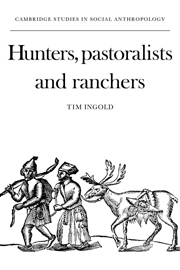Book contents
- Frontmatter
- Contents
- List of figures and tables
- Preface
- Prologue: On reindeer and men
- 1 Predation and protection
- 2 Taming, herding and breeding
- 3 Modes of production (1): hunting to pastoralism
- 4 Modes of production (2): pastoralism to ranching
- Epilogue: On band organization, leadership and ideology
- Locations of circumboreal peoples
- Appendix: The names and locations of circumboreal peoples
- Notes
- Bibliography
- Author index
- Subject index
4 - Modes of production (2): pastoralism to ranching
Published online by Cambridge University Press: 12 September 2009
- Frontmatter
- Contents
- List of figures and tables
- Preface
- Prologue: On reindeer and men
- 1 Predation and protection
- 2 Taming, herding and breeding
- 3 Modes of production (1): hunting to pastoralism
- 4 Modes of production (2): pastoralism to ranching
- Epilogue: On band organization, leadership and ideology
- Locations of circumboreal peoples
- Appendix: The names and locations of circumboreal peoples
- Notes
- Bibliography
- Author index
- Subject index
Summary
Pastoral rationality and cultural adaptation
Central to the thesis I am presenting is the assumption that the property relations of pastoralism, once established, will be reproduced alongside the reproduction of the herds themselves. We must assume, in other words, that a claim over an animal constitutes, ipso facto, a claim over its progeny, insofar as a demonstrable connection can be traced between parent and offspring. No social bond need then exist between the animal and the person or household to which it belongs. From this follows the solution to the paradox, to which I referred in the last chapter, that rights exercised by men in respect of animals become more exclusive as direct relations between men and animals become less so. The social appropriation of carnivorous pastoral herds proceeds solely through the ascription, in the parallel courses of human and animal reproduction, of successive generations in the herds to successive inheritors in chains of lineal descendants, and is not overlain through the cumulative superimposition of transverse ties of domestic incorporation, linking particular animals to particular households.
Granted that access to the productive capacity of the herds is dependent upon the vertical transmission, and reproduction, of privately owned stock, it is readily understandable that every pastoralist should be impelled to increase his holdings in order to guarantee his own livelihood, and that of his children, against the possibility of future loss (Aschmann 1965:267–9).
- Type
- Chapter
- Information
- Hunters, Pastoralists and RanchersReindeer Economies and their Transformations, pp. 201 - 263Publisher: Cambridge University PressPrint publication year: 1980

